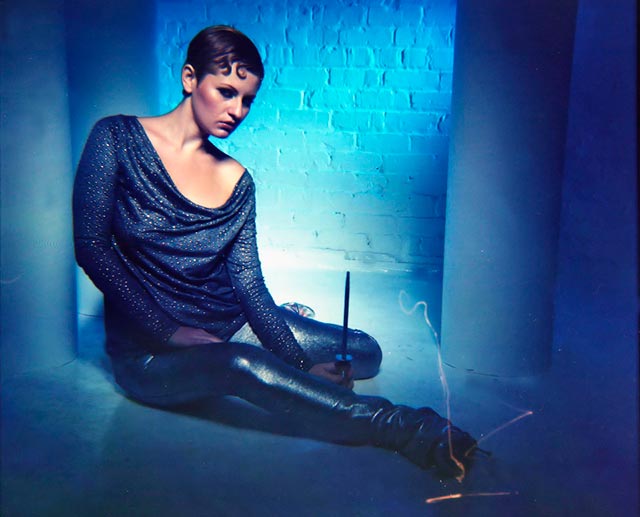
What Exactly Is A Holga Camera
You may recall in Part 1, I reviewed the state of smartphone camera technology and rendered the opinion that if we pay attention to the fundamentals of ISO, aperture, shutter speed, composition, color balance, etc., there are certain situations in which a smartphone is capable of commercial-quality work.
You might also remember that in Part 1, Refining Photo Techniques with Smartphones, I mentioned famed commercial photographer Lee Morris’ “experiment” using an iPhone for a fashion shoot. His point, and the point of Part 1 of this series, is that you don’t need to spend mega-bucks on equipment to get high-quality – even commercial quality – results.
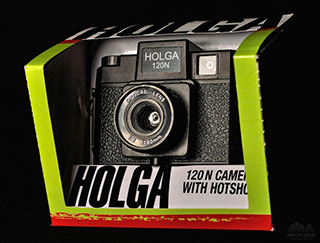
So for purposes of this article, I decided to take Morris’ concept a step further and produce a commercial fashion series using a Holga camera.
What, you might ask, is a Holga? O.K., a little background: remember that the Volkswagen was invented in the 1930’s as a “car for the masses?” Well, the Holga is a camera equivalent. Here’s a brief synopsis:
“In 1982 T.M. Lee created the Holga. His vision was to inspire millions of Chinese to create lasting memories with this simple and affordable camera, at a time when photography was an expensive luxury in China in which few could indulge. Today, more than two decades later, the Holga has inspired millions throughout the world with the unique imagery it creates in the hands of the inspired artist.” (retrieved from http://www.holgainspire.com/html/about.html, February 2014)
The Holga is unusual in that nearly the entire camera is plastic – even the lens. The only metal parts are the shutter spring and the hot shoe on top (more on that in a moment). A medium-format camera, it uses 120 size roll film and produces either 6 x 6 or 6 x 4.5 format negatives, depending on the film mask used. Out of the box, the Holga comes with both mask inserts – plastic of course!
The camera is a study in simplicity. It has one shutter speed – approximately 1/100 second (I call it the “click” shutter speed). It has only two aperture settings, “Sunny” and “Not Sunny.” Focusing is manual, achieved by twisting the lens barrel to the appropriate icon printed on it. When doing close-up work, it helps to have a tape measure, because the “viewfinder” (a simple plastic port hole) is not connected to the lens. Film advance is manual also – you turn the knob on top until the next frame number appears in the red window on the back of the camera.
Part of the appeal to Holga aficionados is its plastic construction, lack of precision, light leaks and characteristic vignetting caused by the plastic meniscus lens, which also contributes to the soft focus and chromatic aberration for which Holga photography is noted.
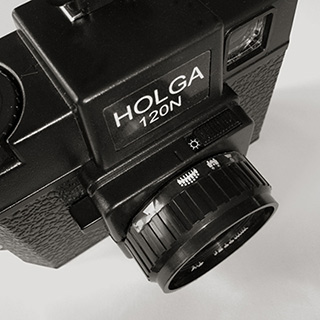
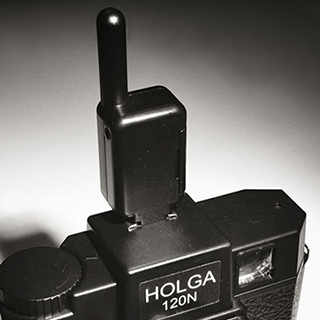
Price? The basic Holga 120N that I use is available from Amazon.com for $27.29 (plus shipping). I’ve seen digital camera lens caps that cost more!
Holga in the Studio
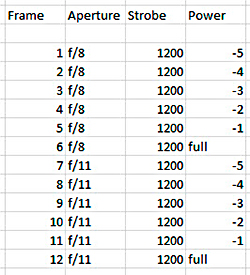
Recording test values prior to beginning live commercial work.
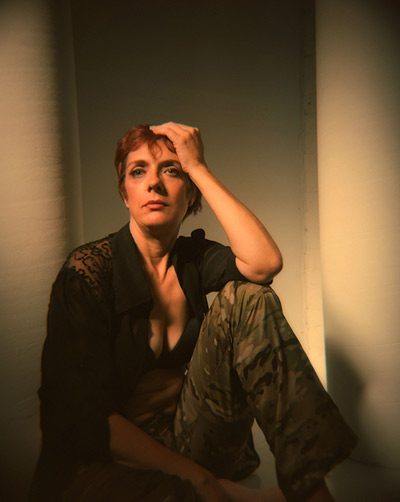
As I mentioned, the Holga camera does have a metal hot shoe on the top that works well with electronic flash accessories, such as a speedlite. This is important because there is no PC cord sync that will work with studio strobe monolights. But – it works very well with a wireless trigger that can control any number of strobes, depending on your configuration.
First things first: we have to test the Holga “system” with the studio strobes for the correct exposure (Image 4). We know the ISO – it’s a characteristic of the film. We have an idea of the shutter speed (maybe 1/100 second… maybe not!). We have a couple of apertures to choose from (“Sunny” or “Not Sunny”). And, we can vary the light output of the strobes. Did someone mention, “light meter?” Oh, yes – it’s a must-have under these circumstances.
Now, let’s try it out on a set with a live model. In our first example – we’re still in test mode here – a very good friend and fellow photographer, Samantha Gibson, graciously agreed to help by posing on the set. Note the characteristic vignetting and chromatic aberration.
Next, let’s “go live” with a sequence featuring the wonderful model Brooke Rey presenting fashions by Arian Chanlé, designed by noted couturier Michael Taylor. In the first photo, see the light squiggle near Brooke’s extended foot? No clue where that came from, but given Holga’s tendency to produce random and unintended effects, it could be a light leak or more probably a burst of static electricity (Lead photo above).
Here, we are using Kodak Portra 160 color film (that’s ISO 160). Because these images are for an editorial spread, they’ve been retouched in a specific style to match the theme of the presentation.
Left: Photographer Samantha Gibson models for the Holga.
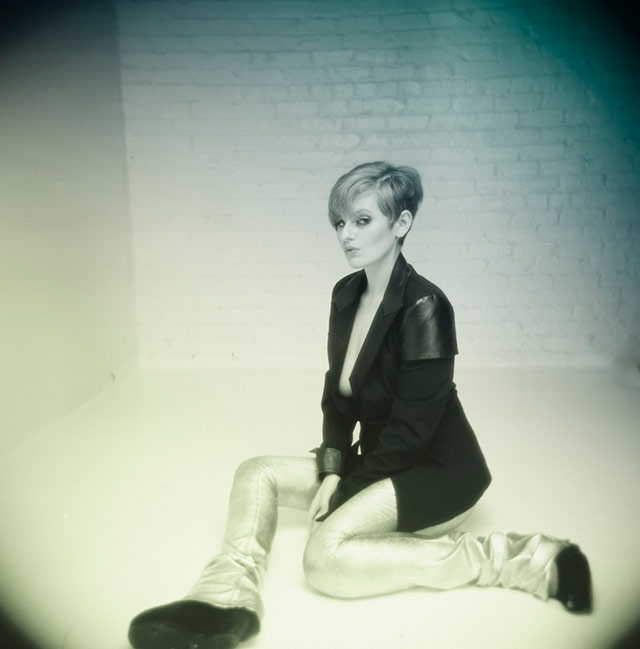
Brooke models an Arian Chanlé ensemble. The vignetting is very pronounced here.
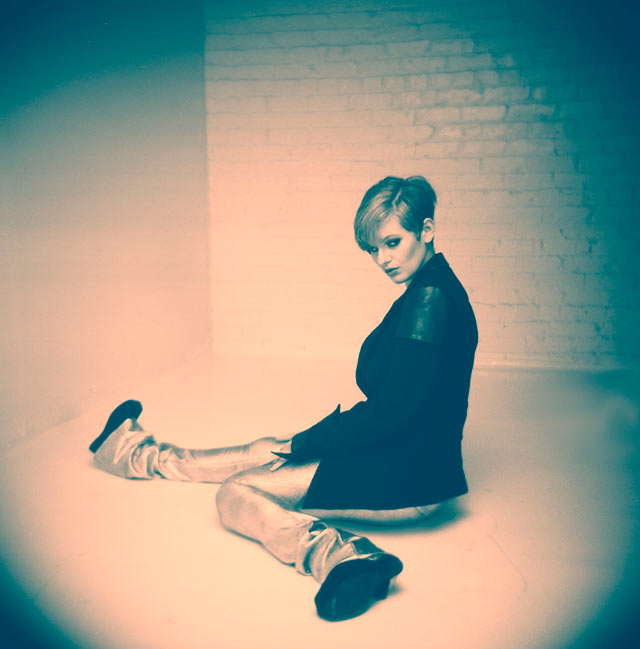
Brooke presents Arian Chanlé in a highly stylized editorial image.
And for our final series, a young newcomer to the fashion scene, Nicole Car, presents the Chanlé Encore lines of specialty gowns and dresses (also designed by Michael Taylor). Using Kodak Portra 400 film, the Holga produces a soft, otherworldly effect that’s perfect to represent the soft nature of the silk jersey knit fabric from which these designs are made.
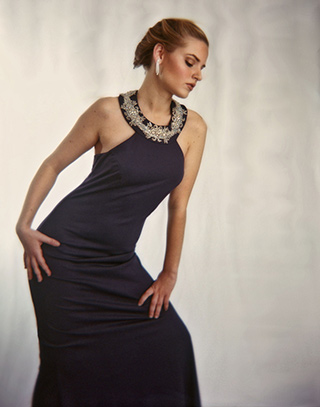
Nicole shows a sleeveless T-back gown with beaded neck and jeweled trim, by Chanlé Encore.
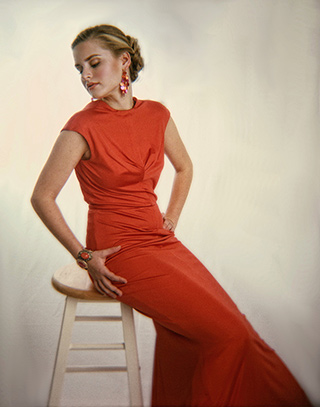
Nicole presents a cap sleeve, pleat-front floor length Chanlé Encore gown.
Post-Production
We’re not done yet! We’re still in the analog world – we have to get the images into digital format so you can see them here, online. Once the film has been developed and contact sheets made for image selection, we have to scan the negatives so we can work with them in the computer (there’s the transition from analog to digital!).
Compared to your average DSLR images, these files are massive – because we’re starting with images that are 6 cm x 4.5 cm in size, far larger than even full-frame sensors found on most digital cameras (except for medium format systems like Hasselblad, Pentax and Mamiya – for which you’d need to take out a second mortgage on your house to afford).
Remember, this is a $27.00 plastic toy camera, plus a few bucks for some film, processing and scanning.
Once we have the negatives scanned to digital form, we can simply print them out to enjoy the images as is, or import them into our favorite retouching program to refine and enhance or apply special effects. Regardless of what you might do with them, Holga images are always an expression of simplicity, a return to an earlier day in photography.
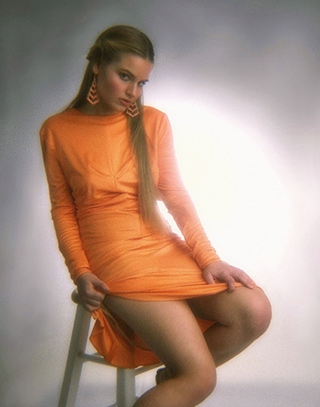
Nicole is flirty in a mid-length long sleeve A-line dress with pleated front, by Chanlé Encore.
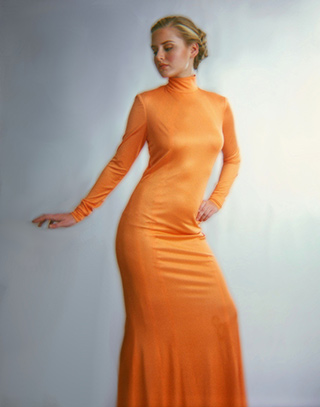
Nicole is in a long sleeve turtleneck Chanlé Encore gown.
The Forrest Gump Effect
I call working with the Holga “Forrest Gump Photography” because of that famous line in the movie: “Like a box of chocolates, you never know what you’re going to get.” Every session with a Holga is an adventure, and every session is different. Forrest Gump was a simple man, and Holga is a simple camera. But if we pay attention to the details, it’s entirely possible to use it in ways that Mr. Lee, the inventor, never imagined.
The Verdict?
In commercial photography, there is an old saying, “People don’t buy photography; people buy photographs.” This is especially true in fashion photography where images must meet the client’s objectives for a specific project. Even though this was an “experiment” – and the client knew it – he was quite happy to see his designs “Holganized” and agreed that the images will be used in his next look book presentation.
What’s Next?
Holga is a film camera, pure and simple. It was not designed for critical commercial work, and I’ll probably never use it that way again. It’s not a camera that you would take with in photography tours for example. But there is a pure joy in getting back to the roots of photography, getting creative, and doing things a little differently.
So, for the next adventure, I’m going to adapt the Holga camera to work with the wet-plate collodion process. Stay tuned.
by Allen Moore
All text and photos: © 2014 Allen Moore. All rights reserved.

Leave a Reply